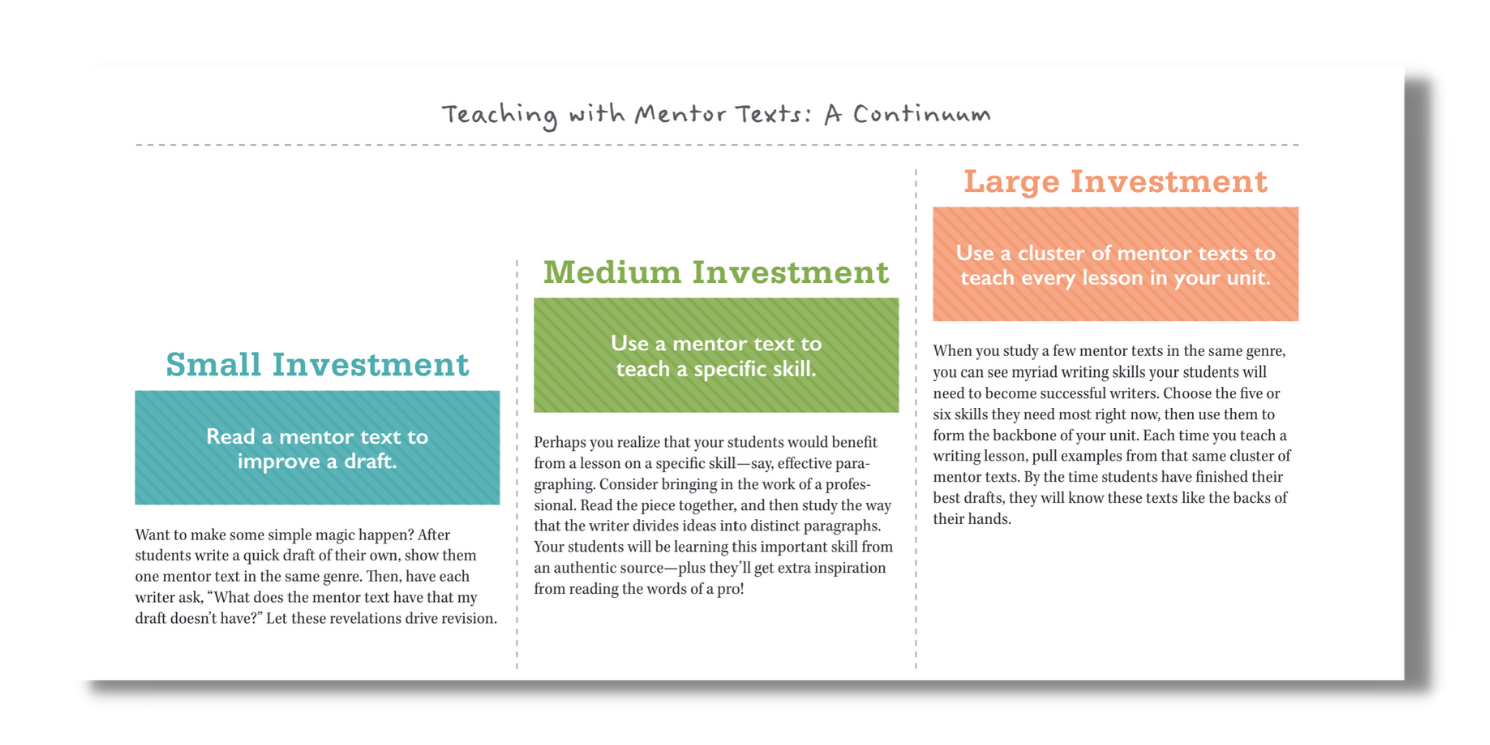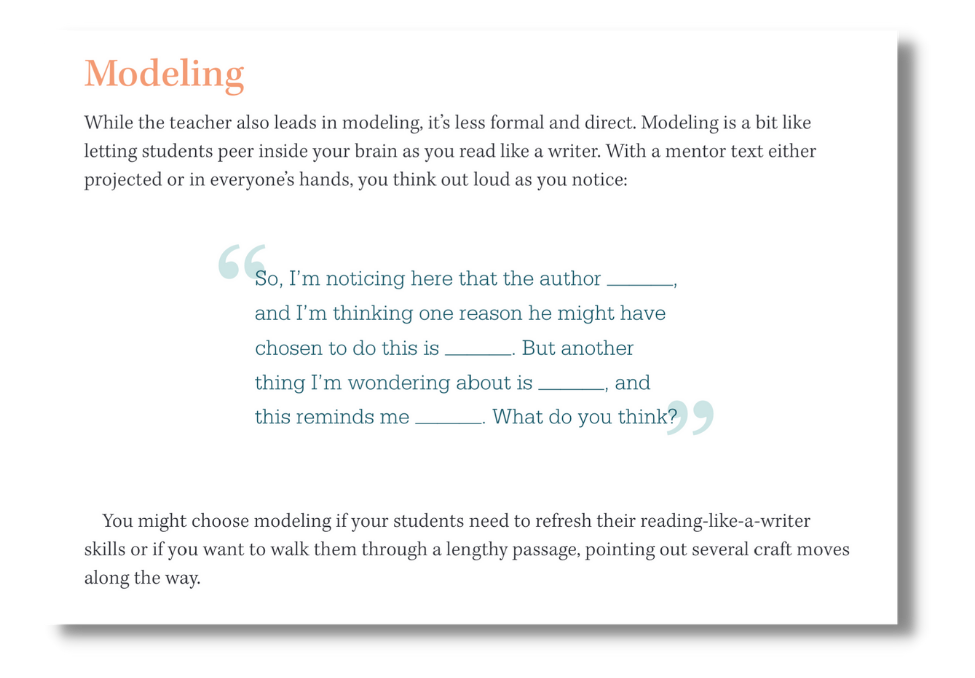
The following is an excerpt from A Teacher’s Guide to Mentor Texts by Allison Marchetti and Rebekah O’Dell.
Teachers use mentor texts in small ways and in large ways—from a ten-minute read-aloud for inspiration to building an entire writing unit.

Watch the video below and learn how to use the Unit Planning Template provided with the online resources for this book.
Planning Teaching
There are three instructional stances you can take while using mentor texts, and the method you choose will depend on your students’ experience with reading like writers and your goal(s) for that particular writing lesson or study.
Direct Instruction
With direct instruction, you take the lead and show your students something in the mentor text that you want them to learn how to do. You might choose direct instruction if your students are new to reading like writers or if there is a particular move you know your students need to practice. This method allows you to teach into those needs clearly and effectively, and having a consistent, predictable structure for this teaching streamlines your planning and frees up time for you to spend observing your students, listening to their questions, conferring with them, and giving them feedback. Here’s an example of that teaching in action. Modeling
Modeling
While the teacher also leads in modeling, it’s less formal and direct. Modeling is a bit like letting students peer inside your brain as you read like a writer. With a mentor text either projected or in everyone’s hands, you think out loud as you notice:  You might choose modeling if your students need to refresh their reading-like-a-writer skills or if you want to walk them through a lengthy passage, pointing out several craft moves along the way.
You might choose modeling if your students need to refresh their reading-like-a-writer skills or if you want to walk them through a lengthy passage, pointing out several craft moves along the way.
Inquiry
In inquiry-based instruction, you and your students work together, sharing responsibility for noticing and naming craft. Successful inquiry work is built upon a foundation of strong direct instruction and modeling. Students need ample opportunities to observe their teacher and try on their own thinking to gain the confidence and tools needed to answer the open-ended question “What do you notice?” When we pull sentences or texts for an inquiry-based craft study, we might have a particular teaching point in mind, or we might just want to give our students an opportunity to build their reading-like-a-writer muscles. We recommend you use inquiry as often as you can. When teachers encourage students to name what they notice separate from any teacher agenda and bring the craft that allures them back to their own work, they write from a place of agency and enthusiasm.
Direct Instruction • Modeling • Inquiry
The most effective teaching blends all three of these methods. In inquiry work, for example, there might be a moment where it makes sense to jump in and offer students some help to name what they see so they can think more deeply about a craft move. Or, during direct instruction, it might make sense to open up the conversation to students with some general questions to help them make connections: Have you seen this craft move before? Where? Can you imagine a place in your own work where it might help?

To learn more about A Teacher's Guide to Mentor Texts visit Heinemann.com.
👉 To read other blogs featuring the book click here.
 Allison Marchetti is coauthor—with Rebekah O'Dell—of Writing with Mentors and Beyond Literary Analysis. Their popular blog Moving Writers focuses on writing instruction in middle and high school classrooms with an emphasis on voice and authenticity. Traveling the country to work with teachers and students provides constant inspiration as they help educators do the hard-and-transformative work of teaching real writing.
Allison Marchetti is coauthor—with Rebekah O'Dell—of Writing with Mentors and Beyond Literary Analysis. Their popular blog Moving Writers focuses on writing instruction in middle and high school classrooms with an emphasis on voice and authenticity. Traveling the country to work with teachers and students provides constant inspiration as they help educators do the hard-and-transformative work of teaching real writing.
Allison has taught middle and high school English in both public and independent schools in Richmond, Virginia. Her favorite moments in the classroom happen at students’ desks, thinking and reading and writing beside them. Rebekah O'Dell is coauthor—with Allison Marchetti—of Writing with Mentors and Beyond Literary Analysis. Their popular blog Moving Writers focuses on writing instruction in middle and high school classrooms with an emphasis on voice and authenticity. Traveling the country to work with teachers and students provides constant inspiration as they help educators do the hard-and-transformative work of teaching real writing.
Rebekah O'Dell is coauthor—with Allison Marchetti—of Writing with Mentors and Beyond Literary Analysis. Their popular blog Moving Writers focuses on writing instruction in middle and high school classrooms with an emphasis on voice and authenticity. Traveling the country to work with teachers and students provides constant inspiration as they help educators do the hard-and-transformative work of teaching real writing.
After more than a decade in the high school classroom, Rebekah currently teaches middle school English in Richmond, Virginia. She has experience using the reading and writing workshop model to transform student engagement at all levels, from inclusion classrooms to the International Baccalaureate program.



